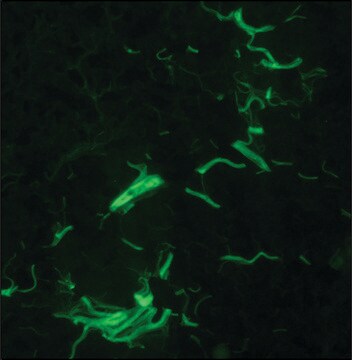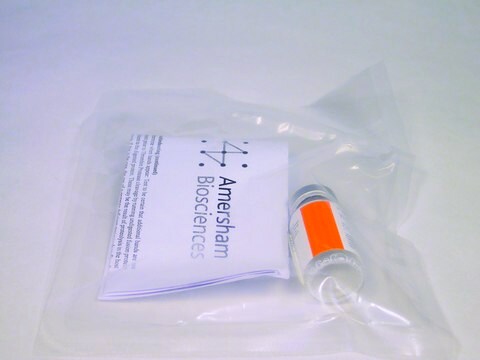SAE0067
SUMO Protease
His tagged recombinant protein, lyophilized powder
Sinônimo(s):
Small Ubiquitin-like Modifier Protease, ULP, Ubiquitin like protease, Ubiquitin-homology domain protein PIC1, Ubl-specific protease 1
Faça loginpara ver os preços organizacionais e de contrato
About This Item
Código UNSPSC:
12352204
NACRES:
NA.54
recombinante
expressed in E. coli
Nível de qualidade
Ensaio
≥95% (SDS-PAGE)
forma
lyophilized powder
peso molecular
27 kDa
Condições de expedição
ambient
temperatura de armazenamento
−20°C
Descrição geral
SUMO proteases are a general class of enzymes that specifically remove the post-translational protein modification (PTM) known as small ubiquitin-related modifier (SUMO), which falls into the PTM class of ubiquitin and/or ubiquitin-like proteins (UBL). The enzyme commonly referred to as ‘SUMO protease′ is the Ubl-specific protease 1 (Ulp1) from Saccharomyces cerevisiae. This was the first of this class of enzymes to be isolated. SUMO protease specifically cleaves the SUMO moiety in a ‘scarless′ manner. SUMO protease recognizes the tertiary structure of the Ubiquitin-like SUMO domain and hydrolyzes the peptide bond in the x–Gly–Gly–x sequence after the Gly-Gly bond, at the C-terminus of the SUMO domain. In addition to cleavage of natural SUMO-modified proteins, SUMO protease is used to cleave recombinant SUMO fusion proteins. The SUMO domain is a known solubility-enhancing fusion tag used in recombinant protein expression. A histidine tag can also be added at the N-terminus of the SUMO domain as a purification tag. This SUMO protease product carries a 6x histidine tag. Thus it can be easily removed together with the cleaved SUMO domain, following the digestion reaction
SUMO protease is active over a wide range of temperatures (2–30 °C), ionic strengths (0–400 mM NaCl), and pH ranges (6–8.5). However, its activity may vary depending on the substrate and conditions. Researchers will need to optimize their specific reaction conditions. As an initial suggestion, 20 units of SUMO protease can be used per mg of target protein for 1 hour at 30 °C, or overnight at 2–8 °C. The cleavage efficiency can then be estimated by SDS-PAGE. If necessary, the amount of SUMO protease can then be adjusted. SUMO protease works better in the presence of reducing agents, e.g., 0.5–2 mM DTT. DTT in the reaction mixture can significantly enhance cleavage efficiency, especially during longer incubations
Store the reconstituted product at –20 °C. It is recommended to reconstitute the enzyme in 100 μL of either water or 50% glycerol (v/v), supplemented with 1 mM DTT. Solutions in water/DTT should be stored in frozen aliquots to avoid freeze-thaw cycles, which can adversely affect the protease activity.
SUMO protease is active over a wide range of temperatures (2–30 °C), ionic strengths (0–400 mM NaCl), and pH ranges (6–8.5). However, its activity may vary depending on the substrate and conditions. Researchers will need to optimize their specific reaction conditions. As an initial suggestion, 20 units of SUMO protease can be used per mg of target protein for 1 hour at 30 °C, or overnight at 2–8 °C. The cleavage efficiency can then be estimated by SDS-PAGE. If necessary, the amount of SUMO protease can then be adjusted. SUMO protease works better in the presence of reducing agents, e.g., 0.5–2 mM DTT. DTT in the reaction mixture can significantly enhance cleavage efficiency, especially during longer incubations
Store the reconstituted product at –20 °C. It is recommended to reconstitute the enzyme in 100 μL of either water or 50% glycerol (v/v), supplemented with 1 mM DTT. Solutions in water/DTT should be stored in frozen aliquots to avoid freeze-thaw cycles, which can adversely affect the protease activity.
Definição da unidade
One enzyme unit is defined as the amount that will cut 90% of 100 pmol of SUMO-GST in 1 hour at 30°C.
Código de classe de armazenamento
11 - Combustible Solids
Classe de risco de água (WGK)
WGK 2
Ponto de fulgor (°F)
Not applicable
Ponto de fulgor (°C)
Not applicable
Certificados de análise (COA)
Busque Certificados de análise (COA) digitando o Número do Lote do produto. Os números de lote e remessa podem ser encontrados no rótulo de um produto após a palavra “Lot” ou “Batch”.
Já possui este produto?
Encontre a documentação dos produtos que você adquiriu recentemente na biblioteca de documentos.
Os clientes também visualizaram
Chuanwu Xia et al.
iScience, 24(10), 103153-103153 (2021-10-15)
The dual function protein ACAD9 catalyzes α,β-dehydrogenation of fatty acyl-CoA thioesters in fatty acid β-oxidation and is an essential chaperone for mitochondrial respiratory complex I (CI) assembly. ACAD9, ECSIT, and NDUFAF1 interact to form the core mitochondrial CI assembly complex.
Camille Le Gall et al.
Journal for immunotherapy of cancer, 10(4) (2022-04-17)
Type 1 conventional dendritic cells (cDC1s) are characterized by their ability to induce potent CD8+ T cell responses. In efforts to generate novel vaccination strategies, notably against cancer, human cDC1s emerge as an ideal target to deliver antigens. cDC1s uniquely
Sho W Suzuki et al.
eLife, 10 (2021-09-16)
Membrane protein recycling systems are essential for maintenance of the endosome-lysosome system. In yeast, retromer and Snx4 coat complexes are recruited to the endosomal surface, where they recognize cargos. They sort cargo and deform the membrane into recycling tubules that
J Brooks Crickard et al.
Cell, 181(6), 1380-1394 (2020-06-06)
Homologous recombination (HR) helps maintain genome integrity, and HR defects give rise to disease, especially cancer. During HR, damaged DNA must be aligned with an undamaged template through a process referred to as the homology search. Despite decades of study
Nossa equipe de cientistas tem experiência em todas as áreas de pesquisa, incluindo Life Sciences, ciência de materiais, síntese química, cromatografia, química analítica e muitas outras.
Entre em contato com a assistência técnica


